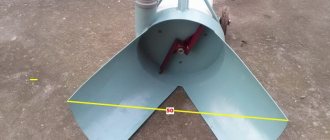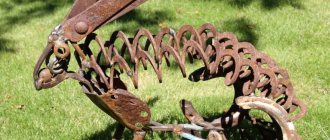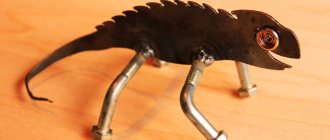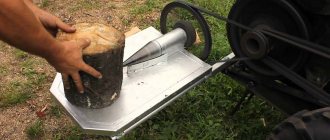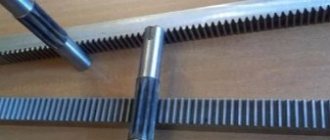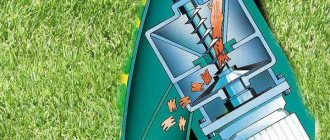Requirements for a cone splitter
A tool that is considered optimal for harvesting wood fuel must meet certain requirements. This applies to any of the existing types, hydraulic, mechanical and conical. The kone log splitter must have the following parameters for successful operation:
- working length (this is the name of the distance between the wedge and the piston, 50 cm is considered optimal);
- good splitting power (5-7 tons is considered standard), necessary for trouble-free splitting of the workpiece;
- sufficient rotation speed (at least 400 rpm, but not more than 600) to apply directed force to the wood fibers;
- the second indicator of speed is the movement of the piston, which is usually done 4 cm/sec forward and 7.5 cm/sec in the opposite direction;
- the presence of a travel limiter, which simultaneously increases productivity and reduces energy consumption;
- quite powerful engine (about 3-4 kW);
- the form and functionality of the screw, where the minimum operating speed determines the performance of both an industrial and home-made device, in which the screw plays one of the determining roles.
Dimensions, power and maximum possible performance are three components of the price when purchasing a device manufactured in an industrial environment.
Fact! A small mechanical model can be purchased for 6 thousand rubles. The more powerful the engine, the breaking force and the performance, the more expensive the device. The price of a wood splitter-screw can reach from 20 thousand rubles*. up to 125 thousand rubles*. The last setting chops a 40 cm workpiece in 2 seconds.
Screw wood splitter diagram
Instructions
According to experts, a competent drawing can be called half the success. Decide what type of wood your device will primarily work with. Calculate the required amount of materials. Next, you need to assemble a standard frame from a metal profile, channel, I-beam and angle. Before making the frame, take all the necessary measurements. Their clarity determines the safety of using the device and its performance.
To ensure the stability of the rack product, purchase wheels that will need to be mounted on the block. Pay special attention to such an element of the device as the piston. It performs an important role: it pushes the log when connecting the wood splitter to the engine. It is imperative to calculate the optimal pushing force.
How to choose?
The choice of tool is dictated by the following criteria:
- weight;
- material;
- dimensions of the ax;
- sharpening shape.
Selecting a tool that matches the physical characteristics of the worker is not the easiest task. If the cleaver is too light, it will be difficult to split massive fragments, and when working with a heavy tool, more physical effort will be spent, but at the same time it will be much easier to split heavy ingots.
It is also important that the ax handle is made of durable wood, which has “astringent” properties. The handle experiences significant load, so it must have the above qualities
A short handle is also not suitable - it is difficult to work with. Handles that are made of PVC or steel are not the best choice. Such axes are expensive, but working with such a tool is inconvenient. Such a tool will not be able to trim trunks soaked in moisture, the diameter of which is more than 25 cm. The ax handle gets stuck in such material quite often.
Thrifty owners, as a rule, use one of two types of axes: classic or wedge-shaped. The first type is convenient for handling freshly cut wood, which contains a lot of moisture. The second type is convenient for splitting dry trimmings of logs.
Cone axes are easy to use and quite effective (especially when working with massive pieces of wood). The pig is installed perpendicularly, a screw is driven into it, then it splits. The work is simply mechanical.
The hydraulic drive helps in solving production problems - it makes it possible to separate logs immediately.
Safety regulations
When working with a device operating at high speed and power, the following points must be taken into account:
- If the piston rotates quickly or does not work properly, you may be injured when cutting a log.
- The device does not function without gasoline, so you need to take care of its availability.
- Rapid feeding of the wooden trunk to the knife can lead to jamming or failure of the tool.
- Before starting work, you need to fill in clean gasoline each time, otherwise the device will jam and the motor will fail.
- When installing a driving cutter, even at the design stage of the device, you need to take care of its correct location. The place must be inaccessible to the working person to avoid accidental injury.
- When operating the unit at high power or reloading wood, it is necessary to protect it from electric current, the supply of which can cause equipment breakdowns and failure of important components.
- It would be correct to install a fuse in the form of a coupling and a thermal relay in the rack-and-pinion log splitter.
Assembly of the structure
Of the two types discussed above, the easiest to implement is the screw wood splitter. This is a simple design without complicated components. It consists of an electric motor, a screw cone, several bearings, a shaft and a gearbox. By the way, the latter can be in the form of a chain belt drive and can be used as a factory unit with a gear drive.
As for the motor, the best option is an electric one, although you can also install a gasoline one if you are building a huge wood splitter. Remember that for a small machine you can take a motor from an unnecessary washing machine, which runs on a voltage of two hundred and twenty volts. Although it has low power, but by installing a high-quality gearbox, you can increase its power a couple of times
It is important to choose all the elements correctly. For example, you can put a small pulley on the motor shaft, and install a huge diameter pulley on the shaft on which the cone is placed.
And the more the difference between the diameters grows, the more powerful the device will be.
Do not forget! A very serious indicator is the rotation speed of the working tool. It should not be higher than 500 rpm. Therefore, you need to choose the right gearbox for the electric motor.
Bearing selection
Now about the selection of bearings. In principle, any can be suitable, the main thing is that the shaft created for them is suitable for the loads acting on it.
For small wood splitters, you can install a shaft with a diameter of 25 mm. Accordingly, bearings with an internal diameter that matches the external diameter of a certain shaft are purchased for it.
The bearings themselves are installed on the device in a special cast iron housing.
The housing can be separate for each bearing or one for two at once. You can buy a body from a craftsman, but it is better to purchase old designs, which can always be found at any scrap metal dump.
The bearings are secured to the frame using bolts. The frame itself at the installation site must be quite strong, therefore, it is in the mounting parts under the bearing housings that a metal profile (angle, channel) is placed, which is welded to the wood splitter frame by electric welding. The base of the machine itself is made of pipes or corners.
Cone
And the most important element of a screw device with a two hundred and twenty volt motor is the cone. Let's start with the fact that it is created from very strong tool steel. Therefore, it is very difficult to create it yourself - even for a master - at home. But this is not worth doing, because screw cones are now sold freely. Remember that you need to choose the right size, because this determines which logs can be cut. Here is the relationship between the dimensions of the cone and the dimensions of the materials being cut for one tool length:
- diameter - seventy mm, bevel size - 1.1. With the specified characteristics, the splitting depth will be approximately 450 mm;
- diameter - eighty mm, bevel - 1.2, split depth - 550 mm;
- diameter - one hundred mm, bevel - 1.5, splitting depth - 750 mm.
Great attention should be paid to the direction of thread cutting. She should be left
That is, when installed, the cone should rest against the log and also pull it towards itself. In fact, with the help of a thread, an auxiliary movement of the part is produced - translational. It turns out that the working element itself will rotate.
This is quite important for domestic type cone log splitters, because they will not have a special feed unit. Everything will be done manually
It is this option that will provide conditions under which it will not be necessary to apply enormous pressure to the wood block being cut.
The choice of cone will depend on its design. There are only two types:
- with shank;
- with an internal special hole.
In the first option, in the shaft on which the cone will be placed, a hole is drilled from the end to accommodate the dimensions and diameter of the shank. The final one is inserted into the hole in the shaft and secured in it using a locking screw, which is installed on one side. In the second option, the shaft itself is inserted into the mounting hole of the cone, where it is secured with two locking screws.
Screw splitter
What is needed for making
Making an “iron lumberjack” does not require the use of scarce parts, so most components and blanks can be found at home or in the garages of friends and acquaintances. Here's what you'll need during the process:
- cone (you can grind the screw yourself or purchase it on the construction market);
- shaft (if you make your own threaded wedge, you can use a suitable hub from agricultural machinery);
- pulleys or sprockets;
- drive belt or chain from automobile or motorcycle equipment;
- bearings with housings (supports for car driveshafts are an excellent option);
- steel profile pipes or angles for the frame;
- metal sheet with a thickness of at least 4 mm for the desktop;
- electric motor;
- wiring;
- switch or magnetic starter;
- RCD;
- bolts and nuts M8 or M10.
Most parts can be used from old automobile or agricultural equipment . The only thing that may be difficult is making a cone screw. However, you should not even try to cut this part using a grinder, as some “authoritative” sources advise. The time spent is not worth the resulting misunderstanding, which can only indirectly be called a screw. Moreover, in operation this “carrot” will not even come one iota close to the efficiency that a cone made by turning will give.
Main components of a cone log splitter
If you plan to use the wood splitter as a mobile unit, then you should take care of durable metal wheels in advance. A truly mobile design is achieved using a gasoline or diesel engine as a power plant.
When making a machine, you will need tools that any “handy” owner will have:
- welding machine;
- electric drill with a set of drills;
- Bulgarian;
- hammer;
- set of wrenches;
- tape measure, marker.
Any enamel for exterior use is suitable for protection against corrosion. It is only important to thoroughly prepare the metal surface for painting, so if necessary, prepare a metal brush (manual, or in the form of an attachment for a drill or grinder), a primer and a rust converter.
Storing logs
When all the firewood is split, they need to be put in a woodpile. A typical mistake of many summer residents and rural residents is that they dump ready-made firewood in a pile. This cannot be done, because a shaky structure can quickly fall apart if at least one log lies poorly. But the most important thing is that firewood piled up does not dry well, which means it can become infected with fungus and mold.
You need to stack firewood carefully, in much the same way as children, when playing, stack construction blocks. Logs, beautifully stacked in a woodpile, look impressive and make a pleasant impression on the neighbors in the country. They are also convenient to take out when you need to bring a few logs home. Firewood should only be stored under a special canopy to prevent rain from falling on it. If they are located outdoors, the wood should be covered from rain with a tarpaulin or plastic film.
People who buy firewood based on an advertisement often complain about the dampness of the delivered wood. In this case, the logs should be dried immediately and only then stacked in a neat stack.
If one of the logs has a wood-boring beetle or other parasite, such a log should be immediately sent to the stove. Parasites are dangerous because they gradually destroy the wood and also make the wood more vulnerable to fungus and mold. Periodically, the logs need to be inspected and checked in what condition they are, and if they are folded beautifully and neatly, this will not be difficult at all.
Splitting firewood with a homemade cleaver is not as difficult as it seems. The main thing is that the ax is comfortable and sharp enough. There is a common misconception that using a sharp ax can easily injure yourself. In fact, lumberjacks most often get injured precisely because the cleaver is not sharpened well enough. By making an ax with your own hands and adapting it “for yourself,” a summer resident or villager will be able to significantly facilitate the annual work of preparing fuel for a Russian stove. This is much simpler and cheaper than buying expensive equipment or purchasing someone else’s firewood of dubious quality.
https://youtube.com/watch?v=m8NCJckjMZI
Owners of country cottages, who heat their homes using a solid fuel boiler or stove, annually prepare up to 12 cubic meters of firewood, depending on needs. It will take several days to prepare such a volume. To speed up the process, you can make your own cleaver - a special device for mechanized chopping of wood.
Operating principle of screw axes
A cone wood splitter, or as they are also called a screw splitter, has a simple operating principle. The cone, pointed on one side, rotates, which allows it to enter the wood like a screw and split it into pieces. Conical screw splitters are considered the simplest, most reliable and durable type of equipment. It is not surprising that, taking into account all the advantages of machines of this type, they have gained the greatest popularity today and are successfully used by summer residents and owners of private houses.
